Managing a Project Team - Free eBook in PDF Format
 |
 |
|
Book Description - ISBN 978-1-62620-984-2 (62 Pages)
There are many reasons why managing people in a project environment are different from managing them in a departmental setting. These differences make the this aspect of the project manager's job more complex than his or her departmental equivalent even though they may be responsible for similar numbers of people. This means that a good project manager requires all of the people skills of a line manger together with an appreciation of the additional issues that exist in the project environment.
Chapter 1 - Managing a Project Team
This area of project management involves ensuring that the project has sufficient human resources, with the correct skill sets and experience, for the project to be successfully completed.
Chapter 2 - Developing the Human Resource Plan
This plan details the project roles, responsibilities, required skills and reporting relationships required for project success. It includes project organization charts and the timetable for staff acquisition and release, and may also include identification of training needs, team-building strategies, recognition programs, compliance considerations and safety issues.
Chapter 3 - Building a Effective Project Team
The process of acquiring a project team takes place within the executing process group and is concerned with confirming human resource availability and obtaining the personnel needed to complete project assignments. Acquiring the project team is often complicated by the fact that the project management team will not usually have direct control over everyone they would like to have involved in the project. They may need to negotiate with others who are in a position to provide the right number of individuals with the appropriate level of knowledge skills and experience.
Chapter 4 - Developing the Project Team
Team performance can be developed by using open and effective communication, developing trust among team members, managing conflicts in a constructive manner, and encouraging collaborative problem-solving and decision-making. This involves tracking team member performance, providing feedback, resolving issues, and managing changes to optimize project performance. Managing human resources is probably one of the most complex areas as people can be unpredictable, can give rise to an expected conflict, the level of their morale can go up or down, and also of course for either personal or professional reasons, some may leave the project in an unplanned manner.
Chapter 5 - Dealing with Conflict in the Project Team
There are two principal conflicts that human resource management seeks to address. The first is the conflict between getting the work of the project done as quickly as possible and the need to develop the skills and competencies of the project team members. The second conflict is between selecting and managing people according to the skills required by the project and managing them as individuals with their own personal and career requirements.
Chapter 6 - Planning Project Communications
The project manager will spend at least half of their working day communicating with project team members and other stakeholders. Communication skills are every bit as important as planning skills and the other technical skills of project management. Unlike technical areas, for example estimating and risk assessment; communication is something that the project manager has to take direct personal responsibility for. The lack of a communication plan is often the biggest single mistake the project manager can make because completing a complex project successfully requires teamwork, and teamwork requires good communication.
Chapter 7 - Optimizing Project Communications
This involves understanding the different communication methods available and selecting those most appropriate to the project. There are many ways to communicate, including unscheduled and informal face-to-face meetings, periodic reports, project Wikis, collaborative software, video-conferencing and email.
Chapter 8 - Managing Project Communications
While all projects share the need to communicate project information, the informational needs and methods of distribution vary widely. Identifying the information needs of the stakeholders and determining a suitable means of meeting those needs are important factors for project success. A poor communications plan will lead to serious problems because required information will be delivered late, people will be sent information that is not relevant to their needs and sensitive information may be sent to people who should not receive it.
Chapter 9 - Identifying Project Stakeholders
This process identifies people, groups, or organizations that could impact or be impacted by a decision, activity, or outcome of the project. It analyzes and documents their interests in and influence on the project. A stakeholder is defined as anyone with an interest in the project, irrespective of whether that interest is positive or negative. They may be individuals or organizations that are actively involved in the project, or whose interests may be affected by the execution or completion of the project.
Chapter 10 - Keeping Stakeholders Informed
The purpose of this process is to keep the various stakeholders informed on the progress of the project. This is done according to the communications management plan. It involves the periodic collection and analysis of baseline versus actual data to understand and communicate the project progress as well as to forecast future performance based on performance to date. The reports themselves can take any format from a simple status report, specifying the percentage of each activity complete to more elaborate reports that include an analysis of past performance, the current status of risks and issues, and other relevant information that could be of interest. The important thing is that there is sufficient information to allow the project manager to use it in other monitoring and management processes and that it is provided in a timely manner.
| You will learn: |
|
![]()
![]()
Background
There is nothing more important to the success of a project than the people who make up the project team.
 |
Without good people - who possess the knowledge, experience, and motivation to get the job done - all of your other planning will be quickly wasted. Assembling a good team is important in any phase of business, but it is especially important when managing a project to make sure that the work can get done on time and on budget.
Developing the HR Plan
 |
Without the right people available, you might find that the project struggles to stay afloat. Much like assembling a team in sports, building a project team requires that the manager take an overall look at the requirements of the project and then fill the team with people whose skills complement each other perfectly. It isn't enough to have great people on a team - those people need to make sense with what they bring to the table and what they can contribute toward the overall end goal of the project.
The project manager must define the skills and knowledge required for each role within the team and then assigns the appropriate responsibilities to each role to ensure that he or she has a cohesive team. Successful project human resources management will build and maintain a team that can bring the vision to life.
Acquiring a Project Team
Putting together a project team is one of the very first steps of setting up a new project. Without the people to compose a quality team, you won't be able to make very much progress at all into the work that needs to be done.
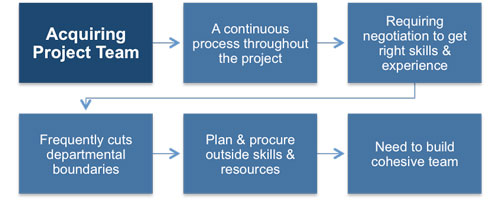 |
There are generally two ways of building a team for a project - assembling in-house talent, and bringing in people from the outside. There are pros and cons to both methods, and a big project will likely need a blend of the two in order to succeed.
In-house Resources
• Using people who are already within the organization is beneficial because they likely have knowledge relevant to the purpose of the project, even if the project is venturing into a new area for the company.
• Many of the skills that they currently use on a regular basis will likely transfer to the project tasks that they take on.
• Additionally, they are already on the payroll and won't cause you to incur some of the other expenses associated with bringing on new talent.
External Resources
However, looking outside the organization is necessary at times depending on what skills will be required.
• Need specialist skills during the project
• One way to have sufficient quantity of a scare resource.
• You are venturing into a new area that isn't normally dealt with in your organization, bringing in new people who are experienced within that field is almost required for success.
These new people could come in the way of full-time employees, part-time employees, or even contractors that you work with for a defined period of time. For each potential member of the project team you need to use a variety of different measures in the decision making process.
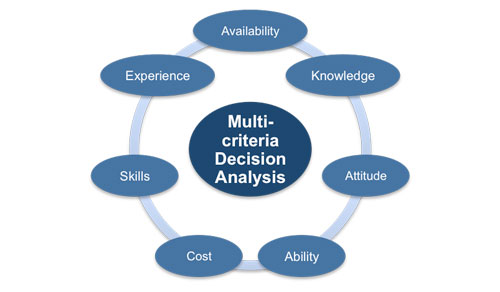 |
No matter who winds up composing your team, or where you acquire them from, building the right kind of team for the project is among the very top priorities of a project manager. Technology has made it easier and easier for companies to work with talented individuals all around the world, so there is really no excuse for not finding the perfect talent for the task at hand.
Developing the Project Team
Even if you are able to assemble a 'perfect' team for your project, there is still work to be done in terms of bringing that team together. Since you are starting up a project that is new to your organization, you will need to mold the team to precisely fit what you are trying to accomplish. As project manager there are several ways you can enhance the performance of your team they are:
• Open & effective communication
• Develop trust amongst members
• Constructive management of conflicts
• Encourage collaborative problem-solving
• Encourage collaborative decision-making.
While all the skills and experiences that you need might exist within the team members, developing the team is still important to get all of them into the right roles and understanding what they are trying to do. This is especially crucial during big projects where they may be a number of smaller groups that report to their own supervisors before answering to the lead project manager. Many of their common concerns are outlined in the diagram below.
 |
If at all possible, the majority of the team development should take place before the project has actually started. You want to be able to hit the ground running within any project, but that is only possible when everyone on the team knows what their role is and what is expected of them. Ideally, the team will feel like a cohesive unit before the project is even officially underway.
Managing the Team
As any experienced leader can attest, expecting a team of people to work together seamlessly from the start of a project to the end is likely unrealistic. Teams are made up of individuals who have their own personalities, feelings, backgrounds, and more.
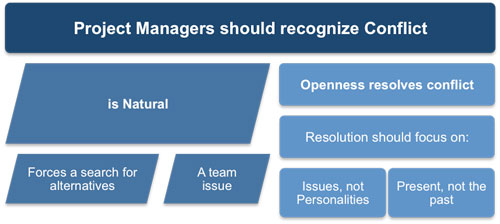 |
It is almost inevitable that some of those people will have disagreements - or even arguments - along the way. It is the job of the project manager to step in and handle these kinds of conflicts to make sure that progress is being made and the project is continuing to move in the right direction. Even if your team is getting along well from a personality standpoint, there is still management to be done.
Overseeing the productivity and reliability of each of your team members is important to stay on track to meeting the deadline of the project as a whole. Only when the individual people that make up your team are on track will the project be able to move forward properly.
The skill of a good project manager really starts to show through when they are able to get the best out of each and every person on the team. Project HR management is critically important for reasons that should be relatively obvious. Without a good team of people working on a project, it is going to have trouble getting traction and is unlikely to ever be completed.
People are what make projects move forward, even more so than resources like equipment or money. Your team can be made up of people from within the organization or include some brought in from the outside to fill specific roles. If you are serious about being successful with your next project, you should leave no stone unturned in finding the best possible team that is available to you.
Communication is one of the great keys to success in life in general. Whether you are talking about communication personally or professionally, being able to deal with other people in a productive and consistent manner is something that can help you thrive. As a project manager, the need to be an effective communicator is evident right from the start.
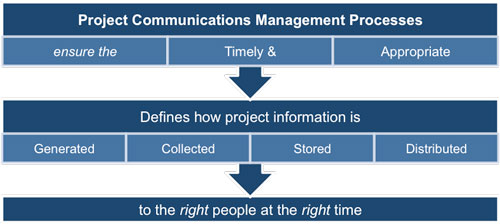 |
With a variety of interested parties related to the project, and a team to lead, there is no doubt that good communication should be near the very top of your priority list. Project communications management is the process of putting a plan in place to help you properly communicate with everyone that has a stake in the project. Just as with anything else related to project management, it is important that you build this plan ahead of time so it can be followed as carefully as possible throughout the work.
Taking a more casual approach to communication will usually lead to frustration and even failure if the people who need specific information don't get it on time, every time. It can be helpful to think of yourself as a project manager as the person that is 'between' the various parties involved in a project.
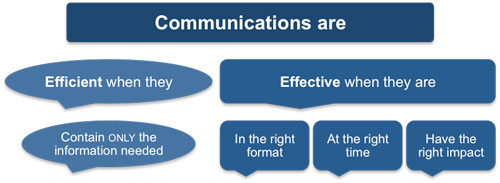 |
Typically, you will have people above you within the organization that want reports on the status of the project - higher ranking officials, owners, investors, etc. At the same time, there is the team of people that are working on the project who typically answer to you. Bridging this gap and ensuring that information is flowing properly in both directions is the challenge that you need to meet.
Who Needs Information?
One of the first steps toward successful project communications management is deciding who needs to receive information. These are often referred to as stakeholders, because they have a stake in the final outcome of the project. In many organizations, the people who initiated the project are going to be those with the most interest in its progress and outcome.
 |
So, if your boss was the one that directed you to take on this project, he or she is an obvious stakeholder, may even be the project sponsor, and will need information regularly. Going beyond your direct supervisor, there will typically be more people that need to receive information about the project. This might include, for example, a board of directors, external groups, regulatory bodies etc.
While they might not have the same level of interest as the person who commissioned the project, a periodic update is likely going to be necessary. Passing along information regularly can also help you reach a successful conclusion to the project.
Project managers want any issues or changes that come up along the way to be dealt with at that time. They do not want them to appear at the end when the work is already completed and any alterations will be costly in both resources and money. Getting input throughout the process should help prevent from work having to be re-done when management or ownership decides to change course.
What Information Do They Need?
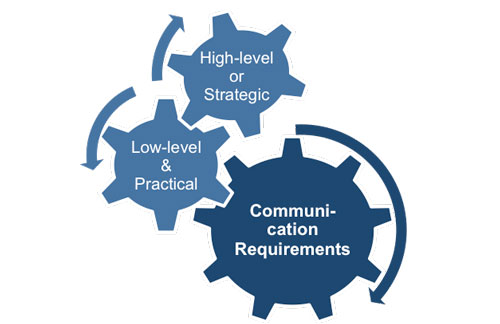 |
With your list of stakeholders clearly established, the next point to determine is what kind of information that group of people will need to receive. It is important to note that the answer to this question is going to vary depending on the group of people in question. For example, your direct supervisor will likely be interested in a high level of detail and description, while the board of directors may just want an overview. Sometimes too much information can be just as harmful as too little, so it is key to determine precisely what each stakeholder will be interested in.
When Do They Need It?
This might just be the most difficult point of all related to project communications management. Passing along information at the right time is important to keeping everybody informed - but not overwhelmed.
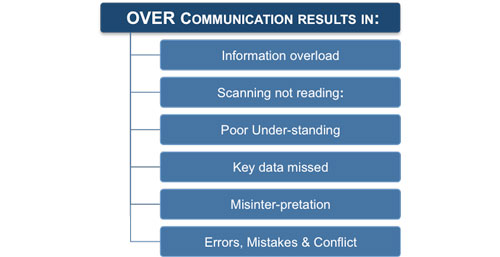 |
You are likely working on the project with your team every day, but the people you are reporting to may not want information that often. Also, it takes time to create communications to pass along, so sending updates too frequently can waste time that could be better spent making progress on the project itself.
To get this point just right, it is important to create a schedule at the start of the project and stick to it as closely as possible, unless something changes. For example, You could plan to update:
• Your direct supervisor / project sponsor every Friday.
• Board of directors on the first Friday of every month.
Obviously this kind of plan will need to be tailored to your specific situation, but the idea is the same - get set with a schedule right from the start and stick to it as closely as possible. Part of the project communications management plan will address the following three questions.
Who is going to do the updating? You might want to deliver the updates yourself, or you could involve members of the team who might have more information relating to the day-to-day progress of the task at hand.
What method of communications will be used? There are plenty of options on this point, especially in the digital age. Email, phone, in-person, via video-conferencing, and more are all possibilities.
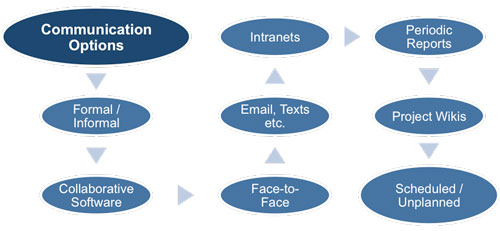 |
Special reports - you might want to define certain milestones that will be reported on outside of the specific communications schedule that has been created. When the project is halfway complete, for example, might be a good time to send a special update to all interested stakeholders.
Being a good project manager and being a good communicator go hand in hand. In order to disseminate information effectively throughout a project, having an established schedule and mode of communication right from the start is necessary. Those initial plans will likely morph along the way, so be prepared to adapt to changes in the project and make sure they are reflected with appropriate changes in your communication plan.
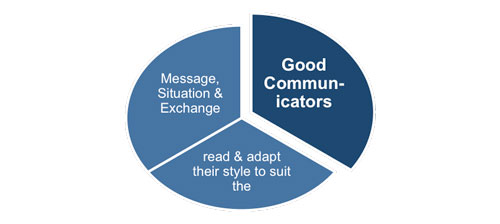 |
Passing along information that is needed by all of your various stakeholders and the project team in a timely manner will make you look more organized as a leader, and give management more confidence in the project as a whole.


